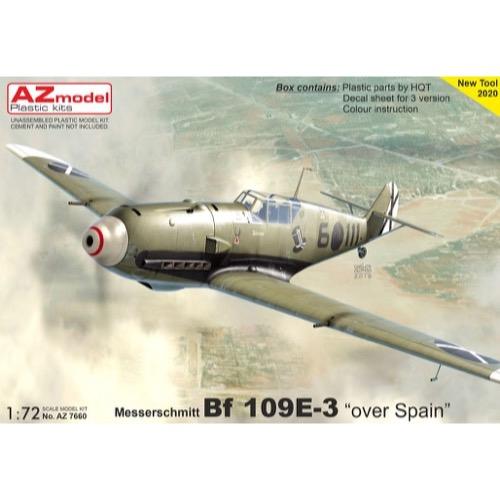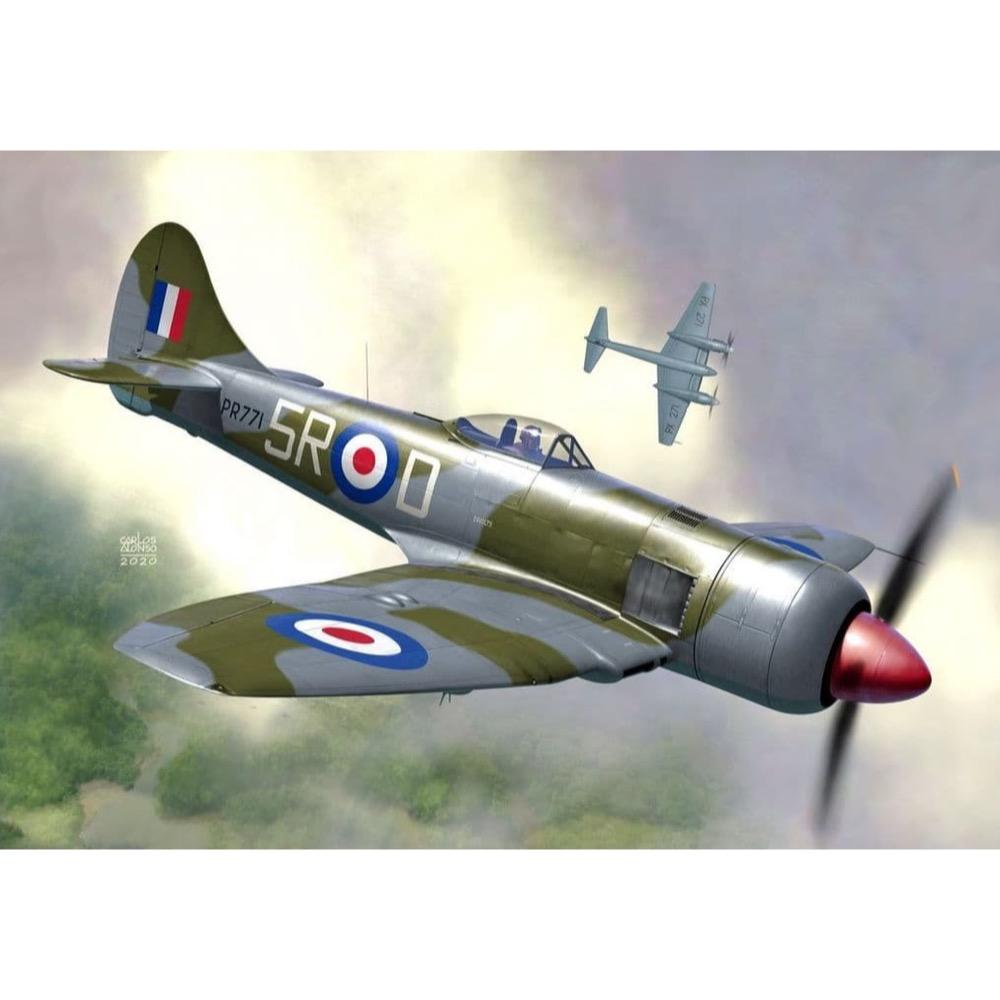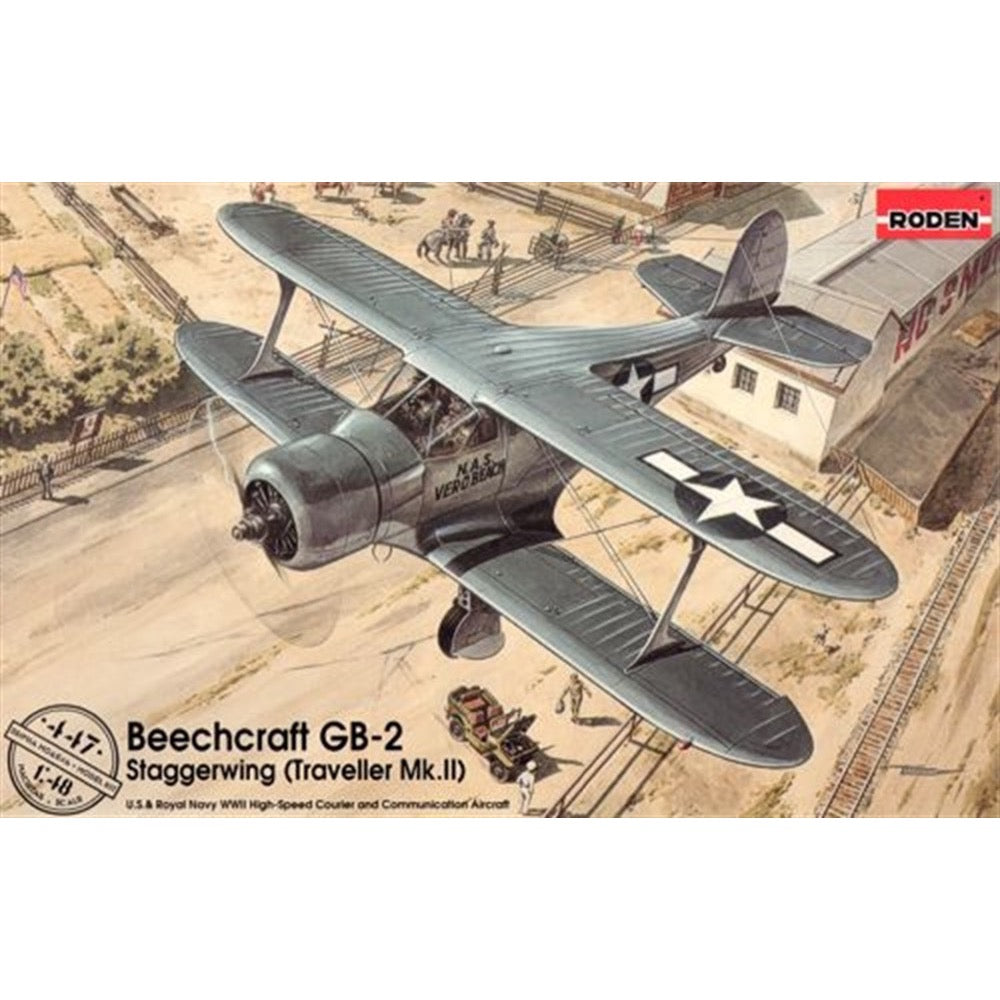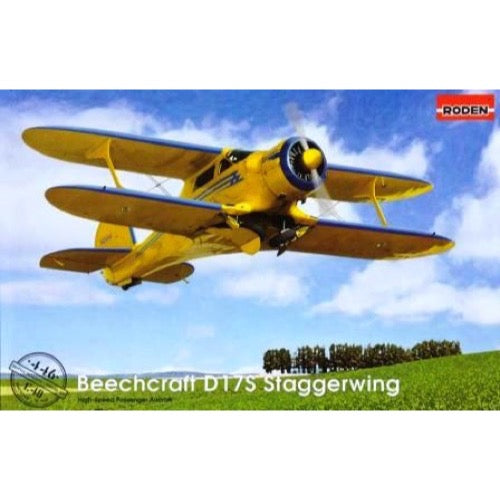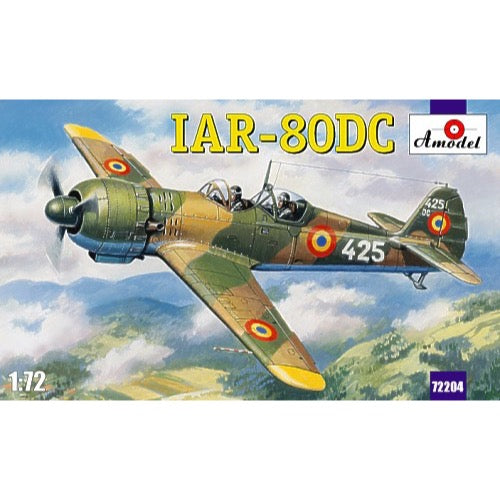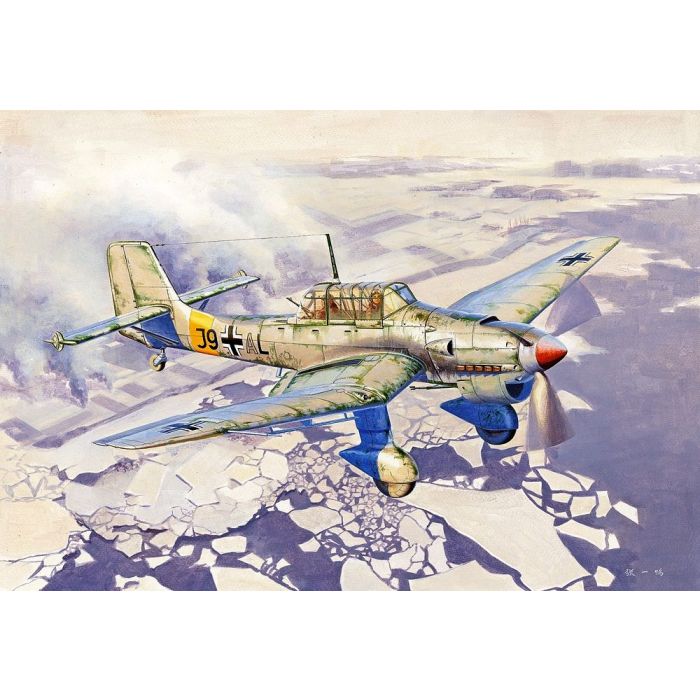
Trumpeter 02422 1/24 Junkers Ju-87B-2/U4 Stuka
83.00
$
<p>The Ju 87B series was to be the first mass-produced variant. A total of six pre-production Ju 87B-0 were produced, built from Ju 87A airframes. Test flights began from the summer of 1937. A small number, at least three, served as conversion Cs or Es for potential naval variants.</p>
<p>The B-2 is the developmental of the B-1 type, they replace the VS5 propeller which the standard on the Ju 87B-1 to the VS11, besides the new exhaust pipe and hydraulic radiator baffle were applied to the aircraft.</p>
<p>The Ju 87B-2/U4 is the B-2 with the skis instead of the three landing gear wheels, the skis were installed by the field factory under the requirements of the front line units.</p>
<h3>Features</h3>
<ul>
<li>Detailed fuselage & wing with accurate design</li>
<li>Highly detailed Engines</li>
<li>Finely detailed cockpit,gear cabin,</li>
<li>Grooved rubber tires</li>
<li>PE parts included</li>
</ul>
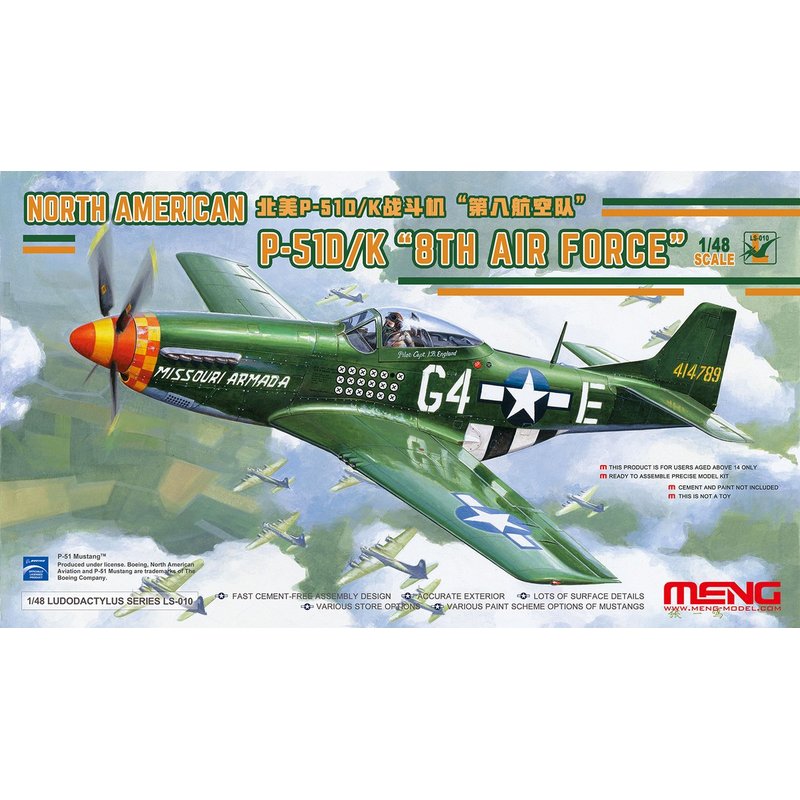
Meng LS-010 1/48 North American P-51D/K 8th Air Force
23.00
$
<p>The U.S. Eighth Army Air Force, also known as the Mighty Eighth, was deployed in Northwest Europe during WWII to carry out the strategic bombing of Germany. Composed of heavy bomber units and fighter units, it's one of the most powerful Air Force units of the U.S. Army. The fighters provided an escort of heavy bombers and swept German airfields. There were many fighter aces in the Eighth Air Forces. Many of them flew Mustangs during the war.</p>
<h3>Features</h3>
<ul>
<li>Highly detailed 1/48 scale plastic model kit of the "North American P-51D/K 8th Air Force". LS-010 North American P-51D/K "8th Air Force".</li>
<li>Model kit provides two paint schemes of the Eighth Air Force aces.</li>
<li>This kit also has features like fast cement-free assembly design, accurate exterior, lots of surface details and various store options.</li>
<li>Length approximately 205mm and its width is about 236mm.</li>
</ul>
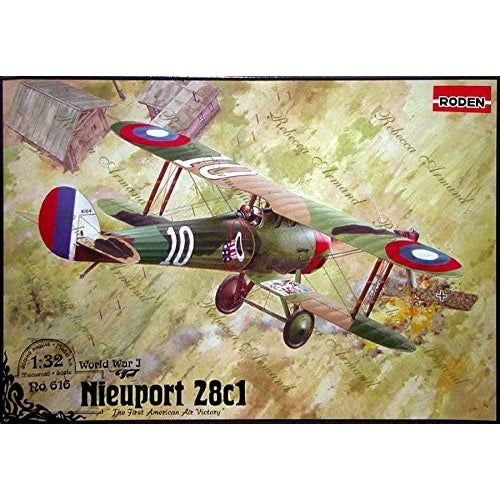
Roden 616 1/32 Nieuport 28c1
35.00
$
<p>In 1917 the French aircraft manufacturer Société Anonyme des Establissements Nieuport produced a series of new fighters the Nieuport 24, the Nieuport 25 and the Nieuport 27. All of these types were progressive modernizations of the famous Nieuport 11 and Nieuport 17, which due to their very good flying characteristics, were possibly the best fighters at the time of their appearance. However, technical progress during the war years stepped on so briskly, that even the most successful designs could become obsolete within the year. At the end of 1917 it was decided to concentrate on building a conceptually new fighter. Unlike its predecessors, which were sesquiplanes rather than standard biplanes, the new fighter had wings of equal span and constant chord, and also an oval section fuselage (this innovation proved its worth in the Nieuport 27).</p>
<p>By the beginning of 1918 there had taken place the first successful test flights of the new machine, designated the Nieuport 28. It was one of the most elegant of contemporary single-seaters: the upper wing sitting close to the fuselage, the fuselage's slim outline, and an elliptical tail assembly completed its aesthetically pleasing looks. A 160 hp Gnome Monosoupape 9N engine was installed in the Nieuport 28, and its armament consisted of two synchronized Vickers guns.</p>
<p>It was intended that the Nieuport 28 would replace another French fighter, the SPAD VIIC.1, which had many problems with its Hispano Suiza engine. However, by the time the Nieuport 28 completed its tests, SPAD had produced a new type the SPAD XIIIC.1. This design exceeded Nieuport's machine in almost every respect and was accepted as the sole new fighter of the Aviation Militaire. It was decided to reject the Nieuport 28, and its fate would probably have been the same as that of hundreds of other relatively successful machines of the time, to remain as a prototype. However, fate decided differently, and the Nieuport 28 achieved its place in the history of aviation as the 'first American fighter'.</p>
<p>After the entry of the United States of America into the war, the American Expeditionary Forces needed airplanes urgently for their own new air force units. The U.S.A. bought a variety of types of airplane at that time, which France made available. In this way the Nieuport 28 became the foundation of American air power in the skies of Europe. The Nieuport firm sold America 297 machines in total, which equipped the 27th, 94th, 95th and 103rd Aero Squadrons.</p>
<p>The Nieuport 28 gained its first victories in April of 1918, when Lieutenants Douglas Campbell and Alan Winslow brought down two German airplanes in the sky of the Western Front.</p>
<p>In this fashion began the history of the United States Army Air Force. The most successful American ace of WWI, Eddie Rickenbacker gained several victories piloting the Nieuport 28. "The well known pilot Quentin Roosevelt, son of the President of the USA Theodore Roosevelt, also flew this airplane."</p>
<p>American pilots spoke approvingly of the maneuverability of the fighter, however, its general performance fell more and more behind that of the enemy's newer types. The Nieuport displayed a dangerous design fault in operation the fabric of the upper wing could simply break away during intensive maneuvering, and as a result there was a series of terrible catastrophes. Little time was spent to remedy this defect, and improve the machine's construction, and operation of the type was reduced to a minimum; but exactly at that time America bought from France the more advanced SPAD XIII in great quantity, and consequently there was no particular need to return the Nieuport 28 to the Front in the summer of 1918, although some machines were still being used at the end of the summer.</p>
<p>With the end of WWI, the American Expeditionary Forces returned to the homeland. The airplanes brought back from Europe became the basis of the new American air arms. The Nieuport 28 was used as a trainer and also for shipboard operation. A few years later the type was officially acknowledged as out-of-date and retired from service. Some machines were used in various civilian 'flying circuses' and also for the needs of Hollywood. Switzerland, Argentina, Greece and Guatemala received some machines.</p>

Meng VS-011 1/35 MB Military Vehicle
20.00
$
<h3>Meng VS-011 1/35 MB Military Vehicle</h3>
<p><strong>Add this reliable workhorse to your collection or diorama today!</strong></p>
<p>This vehicle was mass-produced from around 1941, and served the U.S. Army's soldiers as a reliable battlefield transport. Its excellent performance on rough roads and durability led to it being highly rated by soldiers. This kit reproduces its characteristic rugged appearance and onboard tools, and two types of machine guns are included: a 50 caliber and 30 caliber. The Go-Devil 441 engine is also included.</p>
<p>Plastic scale model set. To assemble, use the fitting and painting guide in the box with pictures and illustrations. The necessary paint, glue and other aids are not included in the kit and must be purchased separately. On our site you will also find various upgrades and accessories that you can use for your construction. When painting, you can also use auxiliary products that create various environmental effects and effects, with which you can achieve the most lifelike effects.</p>
<p>The product is recommended from the age of 14, but with the help of an adult, the construction of models can be started from the age of 10. At this age, it already provides an excellent experience and develops dexterity and logical thinking very well.</p>
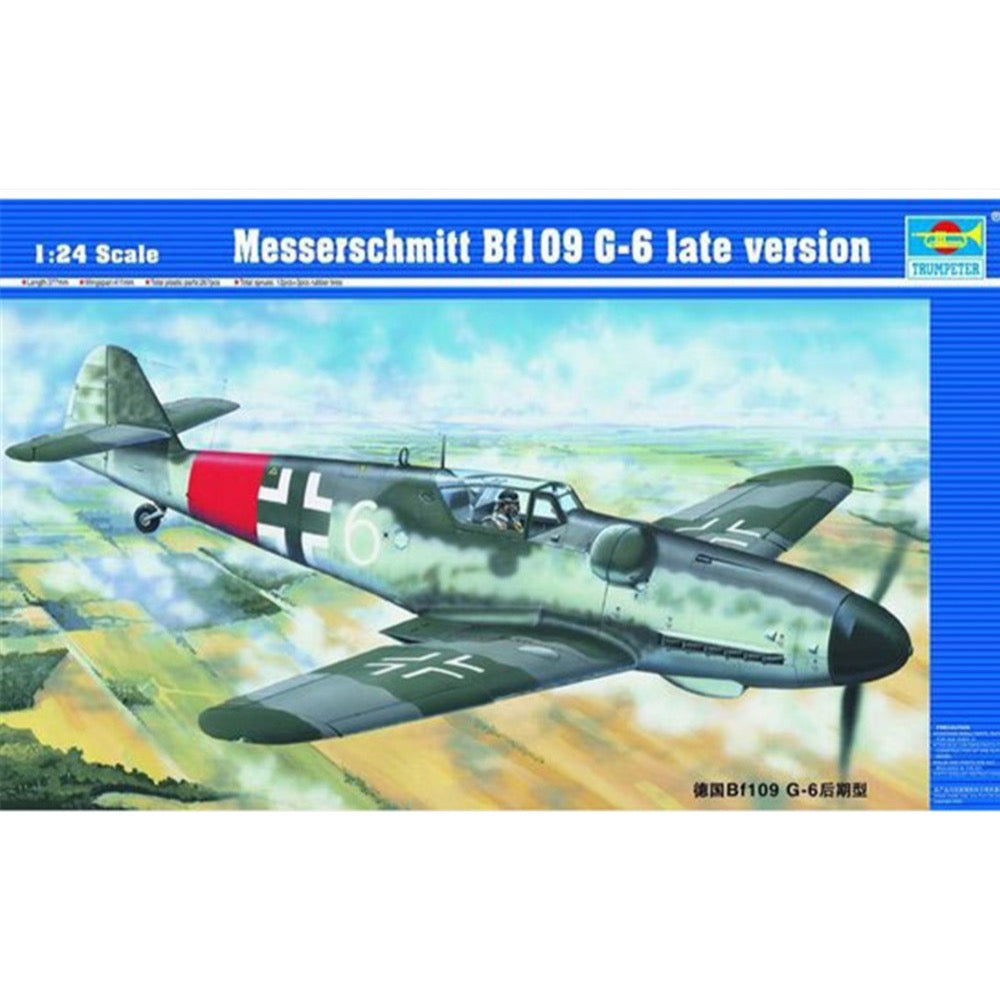
Trumpeter 02408 1/24 Messerschmitt BF109G 6 Late Version
62.00
$
<p>The Gustav, the nick name of Bf-109 G6 was the most heavily produced variant of the 109 series. Wartime development tried to make the plane a more suitable bomber interceptor. Depending on availability of this bigger weapon, some Bf 109Gs had a nose-mounted 30 mm Mk 108 cannon instead of the 20 mm type. Also, some planes were fitted with Rustsatze (add-ons), like the R-6 modification kit adding two more MG151/20 20mm guns in under wing gondolas, for a better efficiency against allied bombers. As the War wore on efforts were made to upgrade the 109's firepower. Several compromises were made to make the Gustav a better bomber interceptor. 20MM cannon pods mounted gondola fashion under the wings are seen on the R6 Variant on War birds.</p>
<h3>Features</h3>
<ul>
<li>Total Parts 267pcs</li>
<li>Photo Etched Parts Aileron & Flap hinges</li>
<li>Film Parts Instrument part</li>
<li>Total Sprues 12pcs + 3pcs rubber tires</li>
<li>Paint Schemes Me 109G-6, I./JG302, Uffz. Willi Reschke 1944.8</li>
</ul>
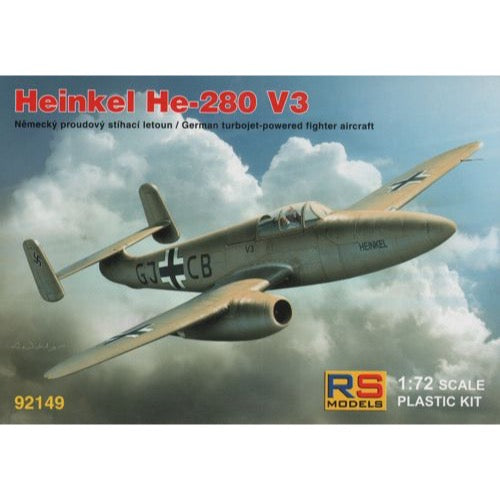
RS Models 92149 1/72 Heinkel He-280V-3
21.00
$
<p>The Heinkel He 280 was a German jet fighter from the Second World War, which had several world firsts to its credit. It was the first of its kind, which was not built only as an experimental aircraft, and thus could claim the title of the world's first combat jet aircraft, even a twin-engined one. <span>Although the test results were very promising and it was a full-fledged combat machine, it did not arouse interest from official places, because at that time the leadership of the German army still believed that victory was within reach, so they rejected something that they could not deploy immediately.</span></p>
<h3>Features<br>
</h3>
<ul>
<li>Decals for He-280, V3, summer 1941</li>
<li>
<span>Decals for </span>He-280 A, 3./JG300, 1944 /alternate marking/</li>
<li>
<span>Decals for </span>He-280 A, 14./JG4, 1944 /alternate marking/</li>
<li>
<span>Decals for </span>He-280 A, 1./JG51, 1944 /alternate marking/</li>
</ul>
<p><br></p>


